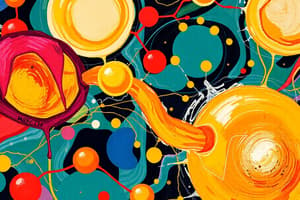Podcast
Questions and Answers
What is estramustine classified as due to its properties?
What is estramustine classified as due to its properties?
- A bioprecursor prodrug.
- A carrier-linked prodrug.
- An inactive compound.
- A mutual prodrug. (correct)
What is an effect of 17α-estradiol on prostate cancer cells?
What is an effect of 17α-estradiol on prostate cancer cells?
- It has no effect on cancer cells.
- It slows the growth of cancer cells. (correct)
- It promotes the growth of cancer cells.
- It increases testosterone levels.
How can the water solubility of estradiol be increased?
How can the water solubility of estradiol be increased?
- Through phosphorylation. (correct)
- By oxidation of its functional groups.
- By reducing its molecular size.
- By adding more carbon chains.
What is a major drawback of bioprecursor prodrugs?
What is a major drawback of bioprecursor prodrugs?
How does sulindac, as a prodrug, affect GI irritation?
How does sulindac, as a prodrug, affect GI irritation?
What happens to sulindac after absorption in the small intestine?
What happens to sulindac after absorption in the small intestine?
What characteristic of hetacillin enhances its lipophilicity?
What characteristic of hetacillin enhances its lipophilicity?
What happens to the amide nitrogen and alpha-amino functionalities in hetacillin?
What happens to the amide nitrogen and alpha-amino functionalities in hetacillin?
What is the primary advantage of converting drugs containing carboxylic acid or alcohol functionalities to esters?
What is the primary advantage of converting drugs containing carboxylic acid or alcohol functionalities to esters?
Which type of enzymes are primarily responsible for hydrolyzing ester prodrugs?
Which type of enzymes are primarily responsible for hydrolyzing ester prodrugs?
What characteristic of the promoiety, such as acetone, is essential for its use as a prodrug?
What characteristic of the promoiety, such as acetone, is essential for its use as a prodrug?
Which factor is NOT mentioned as a benefit of decreasing the hydrophilicity of a prodrug?
Which factor is NOT mentioned as a benefit of decreasing the hydrophilicity of a prodrug?
Which of the following accurately describes a reason for the popularity of esters as prodrugs?
Which of the following accurately describes a reason for the popularity of esters as prodrugs?
What is the role of microflora present within the gut in relation to prodrugs?
What is the role of microflora present within the gut in relation to prodrugs?
When manipulating the electronic properties of the pro-moiety, what is one outcome that can be controlled?
When manipulating the electronic properties of the pro-moiety, what is one outcome that can be controlled?
Which of these statements about esters as prodrugs is FALSE?
Which of these statements about esters as prodrugs is FALSE?
What happens to the azo linkage in sulfasalazine within the gut?
What happens to the azo linkage in sulfasalazine within the gut?
What is the primary active agent released from sulfasalazine?
What is the primary active agent released from sulfasalazine?
How does the prodrug approach benefit the treatment of ulcerative colitis?
How does the prodrug approach benefit the treatment of ulcerative colitis?
What type of compound is methenamine classified as?
What type of compound is methenamine classified as?
What occurs during the activation of bioprecursor prodrugs?
What occurs during the activation of bioprecursor prodrugs?
What is the main function of the quinone functionality in mitomycin C?
What is the main function of the quinone functionality in mitomycin C?
Which type of activation is most commonly seen in bioprecursor prodrugs?
Which type of activation is most commonly seen in bioprecursor prodrugs?
Which property of mitomycin C makes it less selective for hypoxic cells?
Which property of mitomycin C makes it less selective for hypoxic cells?
What is the role of enteric-coated capsules in the delivery of methenamine?
What is the role of enteric-coated capsules in the delivery of methenamine?
What is a consequence of the acidic pH in the urine for methenamine?
What is a consequence of the acidic pH in the urine for methenamine?
What is the primary mechanism by which tirapazamine activates in hypoxic conditions?
What is the primary mechanism by which tirapazamine activates in hypoxic conditions?
How does the hydroquinone formed from mitomycin C contribute to its mechanism?
How does the hydroquinone formed from mitomycin C contribute to its mechanism?
What characteristic makes tirapazamine a more selective agent than mitomycin C?
What characteristic makes tirapazamine a more selective agent than mitomycin C?
What type of radical species is generated during the activation of tirapazamine?
What type of radical species is generated during the activation of tirapazamine?
What is one notable difference between the activation of mitomycin C and tirapazamine?
What is one notable difference between the activation of mitomycin C and tirapazamine?
What happens to the DNA under aerobic conditions when mitomycin C is activated?
What happens to the DNA under aerobic conditions when mitomycin C is activated?
What is the primary purpose of phosphorylation in metabolic functions?
What is the primary purpose of phosphorylation in metabolic functions?
How does phosphorylation affect antiviral agents like nucleosides?
How does phosphorylation affect antiviral agents like nucleosides?
Which of the following describes the selective toxicity of nucleoside antiviral agents?
Which of the following describes the selective toxicity of nucleoside antiviral agents?
What is the role of idoxuridine as an antiviral agent?
What is the role of idoxuridine as an antiviral agent?
What is a consequence of incorporating phosphorylated antiviral agents into DNA?
What is a consequence of incorporating phosphorylated antiviral agents into DNA?
Which factor contributes to the selectivity of antiviral agents over normal cells?
Which factor contributes to the selectivity of antiviral agents over normal cells?
What is the likely effect of using prodrug approaches in antiviral therapy?
What is the likely effect of using prodrug approaches in antiviral therapy?
What can be inferred about the potential toxicity of idoxuridine?
What can be inferred about the potential toxicity of idoxuridine?
Flashcards are hidden until you start studying
Study Notes
Estramustine
- Estramustine is a mutual prodrug, combining both steroid (17-estradiol) and mustard activity.
- 17-estradiol has an antiandrogenic effect on the prostate, slowing prostate cancer cell growth.
- Phosphorylation of estradiol increases its water solubility, making it a prodrug modification.
- Both carbamate and phosphate esters in estramustine are hydrolyzed by chemical or enzymatic means.
Bioprecursor Prodrugs
- Bioprecursor prodrugs rely on metabolism to activate them, unlike carrier-linked prodrugs.
- Sulindac is an example of a bioprecursor prodrug:
- It's inactive as the sulfoxide but needs to be reduced metabolically to the active sulfide.
- Administration of the inactive form reduces gastrointestinal irritation associated with the sulfide.
- Sulindac is absorbed in the small intestine, reduced to the active sulfide, and may be inactivated by oxidation to sulfone.
Chemical Activation of Prodrugs
- Some prodrugs rely on chemical mechanisms for conversion to their active form.
- Hetacillin is a prodrug of ampicillin, modified with acetone to form an imidazolidinone ring.
- The acetone modification decreases the basicity of the -amino group, making it more lipophilic for absorption.
- Chemical hydrolysis regenerates ampicillin after absorption, releasing the active drug.
Prodrugs of Carboxylic Acids and Alcohols
- Prodrugs containing carboxylic acid or alcohol functional groups can be converted to esters.
- Ester hydrolysis is a common activation mechanism, catalyzed by various esterases in plasma and tissues.
- Ester prodrugs benefit from their ease of formation and hydrolysis, allowing for customized lipophilicity.
Prontosil and Sulfasalazine
- Prontosil is not used anymore but illustrates the azo linkage seen in sulfasalazine.
- Sulfasalazine, used for ulcerative colitis, is cleaved by gut microflora azo reductases.
- Cleavage releases aminosalicylic acid, a colon-specific anti-inflammatory agent, and sulfapyridine.
- This approach concentrates the active agent at the site of action, minimizing systemic absorption.
Carbonyl Prodrug Derivatives
- Several functionalities have been evaluated for carbonyl prodrugs (e.g., aldehydes and ketones), but have not found wide clinical use.
- Methenamine is a prodrug that releases formaldehyde in urine, acting as an antibacterial.
- Methenamine is administered in enteric-coated capsules to prevent premature hydrolysis in the stomach.
- Formaldehyde is released in urine, acting as an antibacterial against bacterial nucleophiles.
Bioprecursor Prodrug Activation
- Bioprecursor prodrugs do not contain a carrier or promoiety, but rely on metabolic or chemical transformation to the active drug.
- Common activation methods include oxidative activation, reductive activation, phosphorylation, and chemical activation.
Reductive Activation of Mitomycin C
- Mitomycin C, used for bladder and lung cancer, is a good example of reductive activation.
- Mitomycin C contains a quinone that is reduced to a hydroquinone.
- This reduction alters the electron pair of the nitrogen, allowing it to participate in alkylating DNA.
- Mitomycin C's selectivity for hypoxic cells is minimal, but analogues are being explored for better selectivity.
Tirapazamine for Hypoxic Cells
- Tirapazamine, undergoing phase III clinical trials, shows greater selectivity for hypoxic cells than mitomycin C.
- It is activated by a one-electron reduction, catalyzed by cytochrome P-450 and reductase, forming a radical species.
- The radical species initiates DNA chain breaks under hypoxic conditions.
Phosphorylation for Bioactivation
- Phosphorylation is a common metabolic process, producing high-energy phosphodiester bonds like those in ATP and GTP.
- Phosphorylation can activate molecules by introducing a leaving group, which can be displaced by an incoming nucleophile.
- Phosphorylation is crucial for the bioactivation of antiviral agents, converting nucleosides to nucleotides.
Antiviral Prodrug Activation
- Antiviral agents often disrupt DNA or RNA synthesis by being converted to triphosphates.
- Selectivity for viral kinase enzymes over mammalian kinases is important for antiviral prodrugs.
Idoxuridine as an Example
- Idoxuridine, a nucleoside antiviral, enters cells and is phosphorylated preferentially by viral thymidine kinase.
- This preferential phosphorylation leads to greater activation in virally infected cells, providing some selective toxicity.
- Activated idoxuridine inhibits DNA synthesis by blocking viral DNA polymerase and causing incorrect base pairing.
- The prodrug approach enhances cell penetration and can contribute to selective toxicity.
Studying That Suits You
Use AI to generate personalized quizzes and flashcards to suit your learning preferences.




